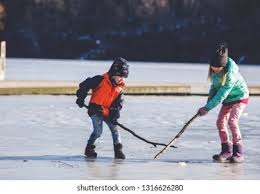A powerful image reflecting the cultural symbols of Canadian hockey discourse is the iconic scene of kids playing on a frozen pond, representing the sport as a unifying national tradition. However, this narrative often excludes Indigenous contributions and experiences, overlooking how hockey has also been a space of exclusion and assimilation for Indigenous players. While hockey is seen as a symbol of Canadian identity, it’s important to recognize whose stories have been centered, and whose have been erased, in this discourse.
4
These are difficult stories. We bear witness in this chapter to the role of sport in furthering the settler colonial projects throughout Turtle Island. Here are some supports to access in the community and from a distance:
First Peoples House of Learning Cultural Support & Counselling
Niijkiwendidaa Anishnaabekwag Services Circle (Counselling & Healing Services for Indigenous Women & their Families) – 1-800-663-2696
Nogojiwanong Friendship Centre (705) 775-0387
Peterborough Community Counselling Resource Centre: (705) 742-4258
Hope for Wellness – Indigenous help line (online chat also available) – 1-855-242-3310
LGBT Youthline: askus@youthline.ca or text (647)694-4275
National Indian Residential School Crisis Line – 1-866-925-4419
Talk4Healing (a culturally-grounded helpline for Indigenous women):1-855-5544-HEAL
Section One: History
A) The Residential School System
Exercise 1: Notebook Prompt
We are asked to honour these stories with open hearts and open minds.
Which part of the chapter stood out to you? What were your feelings as you read it? (50 words)
| One part of the chapter that stood out to me was the idea that sport was not a neutral or positive force in residential schools but rather an essential tool for cultural genocide. It was unsettling to realize that sports were used to replace Indigenous traditions and reinforce colonial control. It made me reflect on how deeply systemic racism shaped even seemingly “apolitical” activities.
|
B) Keywords
Exercise 2: Notebook Prompt
Briefly define (point form is fine) one of the keywords in the padlet (may be one that you added yourself).
| Settler colonialism is invasive, oppressive, and ongoing. It’s about taking land, erasing cultures, and enforcing control while pretending it’s progress. It’s not just a thing of the past, it still shapes systems and lives today.
|
C) Settler Colonialism
Exercise 3: Complete the Activities
Exercise 4: Notebook Prompt
Although we have discussed in this module how the colonial project sought to suppress Indigenous cultures, it is important to note that it also appropriates and adapts Indigenous cultures and “body movement practices” (75) as part of a larger endeavour to “make settlers Indigenous” (75).
What does this look like? (write 2 or 3 sentences)
| This looks like settlers adopting Indigenous symbols, practices, and sports while stripping them of their original meaning and context. For example, traditional Indigenous games were replaced with Euro-Canadian sports in residential schools, yet elements of Indigenous movement practices were later appropriated into mainstream fitness and wellness trends. This process allows settlers to claim a connection to the land and its original peoples while continuing to erase Indigenous sovereignty and cultural significance.
|
D) The Colonial Archive
Exercise 5: Complete the Activities
Section Two: Reconciliation
A) Reconciliation?
Exercise 6: Activity and Notebook Prompt
Visit the story called “The Skate” for an in-depth exploration of sport in the residential school system. At the bottom of the page you will see four questions to which you may respond by tweet, facebook message, or email:
How much freedom did you have to play as a child?
What values do we learn from different sports and games?
When residential staff took photos, what impression did they try to create?
Answer one of these questions (drawing on what you have learned in section one of this module or prior reading) and record it in your Notebook.
| Sports and games often teach values like teamwork, discipline, and perseverance, but the lessons they impart depend on the context in which they are played. In many Indigenous communities, traditional games were deeply tied to culture, storytelling, and community connection. However, in residential schools, Euro-Canadian sports were used as tools of assimilation, replacing Indigenous physical practices and reinforcing colonial control. Rather than providing true freedom and belonging, sports in this setting served to impose settler values and erase Indigenous traditions, making them part of the larger project of cultural suppression.
|
B) Redefining Sport
B) Sport as Medicine
Exercise 7: Notebook Prompt
Make note of the many ways sport is considered medicine by the people interviewed in this video.
| In the video, sport is considered medicine in many ways by the people interviewed. They describe it as a source of healing, both physically and mentally, helping individuals cope with trauma and find strength. Sport builds community, provides connection, and provides a sense of belonging, especially for Indigenous youth. It offers an outlet for self-expression, personal growth, and resilience, helping individuals reconnect with their culture and identity. Through movement, teamwork, and perseverance, sport becomes a powerful tool for healing and empowerment. |
C) Sport For development
Exercise 7: Notebook Prompt
What does Waneek Horn-Miller mean when she says that the government is “trying but still approaching Indigenous sport development in a very colonial way”?
| Waneek Horn-Miller means that while the government is making efforts to support Indigenous sport development, it is still doing so through a colonial framework,one that imposes external structures rather than centering Indigenous leadership, traditions, and ways of knowing. Instead of empowering Indigenous communities to define and lead their own sports programs, policies and funding often reflect settler priorities and bureaucratic control. This approach continues to limit true self-determination and fails to fully embrace the cultural significance of Indigenous sports and movement practices. |
Exercise 8: Padlet Prompt

|
|
Section Three: Decolonization
Please see the major assignment for this half of the term in the final section of this chapter.

